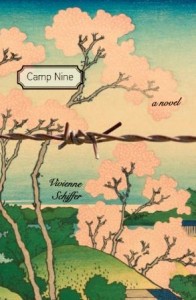
Today, Jack has offered to talk about his writing, his inspiration, and his writing space. Please give him a warm welcome.
Good day, everybody. Jack Caldwell here, the author of THE THREE COLONELS – Jane Austen’s Fighting Men, a sequel to Pride & Prejudice and Sense & Sensibility, now available from Sourcebooks Landmark. My first novel, PEMBERLEY RANCH, a reimagining of Pride & Prejudice set in post-Civil War Texas, came out in 2010.
The kind and lovely Serena asked me to talk to you about how and where I write, and what inspires me. Well, I’m hesitant to do so. You know how shy we authors are. We never want to talk about our work—
Alright, Serena, you can stop laughing hysterically now.
The first thing you must know is that I’m a guy. Therefore, I own my own computer. That may sound like a strange boast, but from what I understand, many of my female compatriots must fight the rest of their family to get computer time to write. I don’t have that problem. This machine is mine. Nobody touches it but me!
(Note: My wife has her own laptop. I ain’t stupid. Happy wife – happy life.)
I’ve taken over one of the spare bedrooms to serve as my office. I have a desk, two printers, the computer, network equipment, files, and bookcases filled with novels and reference books. This is my Pemberley Library, my inner sanctum, my Batcave.
But this is not where I write. This is where I type.
Believe it or not, I write in bed while I sleep — while I dream. You see, I have this uncanny ability to control my dreams. I run the plot of my current writing project through my mind like a movie while I sleep. The best part is when I run into a dead end, stop everything, back up, and try again on a slightly different path, all while remaining asleep. The next day, I transcribe my dream into the computer. Cool, huh?
Now, that doesn’t mean I don’t have a roadmap. I do, because before I write a word, I put together a detailed outline. I know how my story ends before I write it; in fact, the last chapter is often one of the first I write. This way, I always finish my projects.
I also depend on a team of extraordinary women to help me. They are my editors, whom I call affectionately my Beta Babes. They go over every word I write. The group has changed membership slightly over the years, but the one constant has been Beta Babe #1, my wife, Barbara.
Writing is a lot of work. Some days I put down only a few hundred words, other days several thousand. But I need to write every day. Even at that pace, it takes between six to nine months to write a novel, averaging 100,000 words.
Then, if my publisher likes it, I get to cut it — a lot. It ain’t fun, but usually her suggestions are the right ones. The finished novel runs about 85,000-95,000 words. We bounce it back and forth, polishing it up, and after the final edit is accepted, we start all over again with a new book.
I’m having a ball.
So how do I get the ideas of what to write? My muse, my dear friends — that harsh mistress who lovingly and relentlessly drives me to write. Here’s her photo:
Hot, isn’t she? She’s the one who challenged me to write in the first place. She helped me overcome a high school teacher who thirty-five years ago told me I had no writing ability.
She also spurs my ideas, especially as she found out writers can write off a portion of their travel if it is used for research for their work. She’d LOVE it if I wrote a Pride & Prejudice reimagining set in Hawaii! Who knows—maybe one day…?
Anyhow, I hope all of you enjoy THE THREE COLONELS, especially as I’m writing a sequel to it right now. Which means that not everybody dies in it (I have such a bad reputation about that).
And remember, it takes a real man to write historical romance, so let me tell you a story.
~*~*~
So, which do you like better—sequels or reimaginings? Where would you move your favorite Austen characters in time and space? Let’s have some fun!
About the Author:
Jack Caldwell is an author, amateur historian, professional economic developer, playwright, and like many Cajuns, a darn good cook. Born and raised in the Bayou County of Louisiana, Jack and his wife, Barbara, are Hurricane Katrina victims who now make the upper Midwest their home.
His nickname—The Cajun Cheesehead—came from his devotion to his two favorite NFL teams: the New Orleans Saints and the Green Bay Packers. (Every now and then, Jack has to play the DVD again to make sure the Saints really won in 2010.)
Always a history buff, Jack found and fell in love with Jane Austen in his twenties, struck by her innate understanding of the human condition. Jack uses his work to share his knowledge of history. Through his characters, he hopes the reader gains a better understanding of what went on before, developing an appreciation for our ancestors’ trials and tribulations.
When not writing or traveling with Barbara, Jack attempts to play golf. A devout convert to Roman Catholicism, Jack is married with three grown sons.
Check out Jack’s blog, The Cajun Cheesehead Chronicles, at Austen Authors, his Website — Ramblings of a Cajun in Exile — and his Facebook page.
Thanks, Jack, for sharing your writing and inspirations with us. Also check out my review of Pemberley Ranch. I personally love both sequels and reimaginings! And I cannot wait for the sequel to The Three Colonels!
 Good day, everybody. Jack Caldwell here, the author of
Good day, everybody. Jack Caldwell here, the author of  The first thing you must know is that I’m a guy. Therefore, I own my own computer. That may sound like a strange boast, but from what I understand, many of my female compatriots must fight the rest of their family to get computer time to write. I don’t have that problem. This machine is mine. Nobody touches it but me!
The first thing you must know is that I’m a guy. Therefore, I own my own computer. That may sound like a strange boast, but from what I understand, many of my female compatriots must fight the rest of their family to get computer time to write. I don’t have that problem. This machine is mine. Nobody touches it but me! Believe it or not, I write in bed while I sleep — while I dream. You see, I have this uncanny ability to control my dreams. I run the plot of my current writing project through my mind like a movie while I sleep. The best part is when I run into a dead end, stop everything, back up, and try again on a slightly different path, all while remaining asleep. The next day, I transcribe my dream into the computer. Cool, huh?
Believe it or not, I write in bed while I sleep — while I dream. You see, I have this uncanny ability to control my dreams. I run the plot of my current writing project through my mind like a movie while I sleep. The best part is when I run into a dead end, stop everything, back up, and try again on a slightly different path, all while remaining asleep. The next day, I transcribe my dream into the computer. Cool, huh?
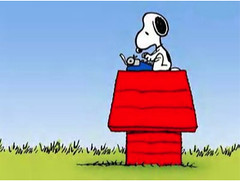 Writing is a lot of work. Some days I put down only a few hundred words, other days several thousand. But I need to write every day. Even at that pace, it takes between six to nine months to write a novel, averaging 100,000 words.
Writing is a lot of work. Some days I put down only a few hundred words, other days several thousand. But I need to write every day. Even at that pace, it takes between six to nine months to write a novel, averaging 100,000 words.
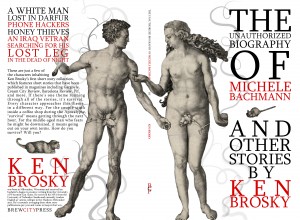
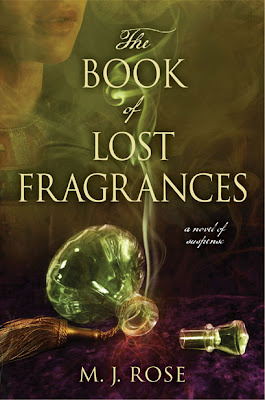


 Today, I’ve got a guest post form Josh Martin about Plot Hinge, a website community dedicated to the serialized novel, especially those shaped by the real world. The site offers a brief history of the serialized novel, and offers some bonus content, including an alternate chapter by Emily St. John Mandel (I reviewed her novel
Today, I’ve got a guest post form Josh Martin about Plot Hinge, a website community dedicated to the serialized novel, especially those shaped by the real world. The site offers a brief history of the serialized novel, and offers some bonus content, including an alternate chapter by Emily St. John Mandel (I reviewed her novel 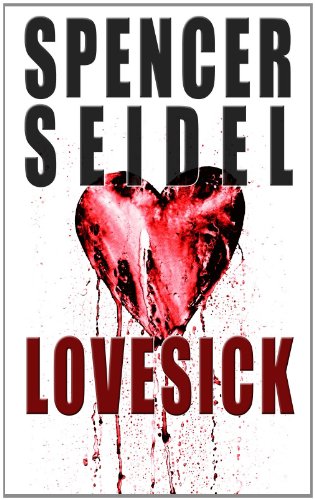

 I moved my workspace to the family room, the heart of my home. It has a big comfortable couch, blankets when I’m cold and it’s close to the kitchen. And most importantly, it had a television. Now I don’t recommend doing homework or writing a best selling book with the television on, but I have to say, with the right program, the white noise, keeps me sane and even focused. And sometimes, a particular program, a word, a thought, a plot twist can inspire something grand.
I moved my workspace to the family room, the heart of my home. It has a big comfortable couch, blankets when I’m cold and it’s close to the kitchen. And most importantly, it had a television. Now I don’t recommend doing homework or writing a best selling book with the television on, but I have to say, with the right program, the white noise, keeps me sane and even focused. And sometimes, a particular program, a word, a thought, a plot twist can inspire something grand.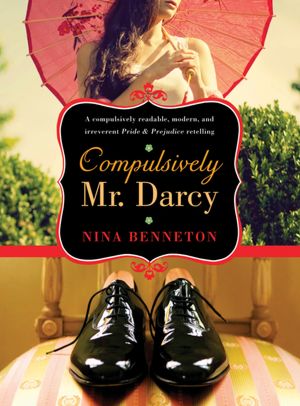
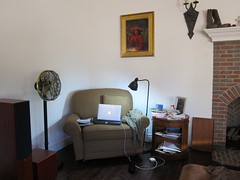 I call this Jane Austen writing space. The family refers to this as Mama’s throne, my Jane Austen writing space in one corner of the family room. On that round table there, I keep whatever reference books I need for the novel I’m working on (three novels concurrently). Six feet to the left of my chair, a piano sits, convenient for me to Tiger-mother-supervise daily piano practice while I’m writing. To the right of my chair is a large, flat-screen TV that’s rarely on, thank goodness. Diagonal from my chair is a large sectional couch where my husband sits and practices his guitar, and where my kids read or play games (and make too much noise). My favorite and best writing time is in the morning, when I wake up at 3:30 AM to get some writing done right in this chair, and the room is quiet and empty. I get the majority of my fresh writing done until 6:00 AM, when the family wakes up. On the weekends, it’s golden because they don’t get up until 9AM or later and I can actually get 6 hours in. I go to bed two hours after the children do, at 10:00PM (after I sneak in some editing or working on writing classes’ assignments).
I call this Jane Austen writing space. The family refers to this as Mama’s throne, my Jane Austen writing space in one corner of the family room. On that round table there, I keep whatever reference books I need for the novel I’m working on (three novels concurrently). Six feet to the left of my chair, a piano sits, convenient for me to Tiger-mother-supervise daily piano practice while I’m writing. To the right of my chair is a large, flat-screen TV that’s rarely on, thank goodness. Diagonal from my chair is a large sectional couch where my husband sits and practices his guitar, and where my kids read or play games (and make too much noise). My favorite and best writing time is in the morning, when I wake up at 3:30 AM to get some writing done right in this chair, and the room is quiet and empty. I get the majority of my fresh writing done until 6:00 AM, when the family wakes up. On the weekends, it’s golden because they don’t get up until 9AM or later and I can actually get 6 hours in. I go to bed two hours after the children do, at 10:00PM (after I sneak in some editing or working on writing classes’ assignments). I call this my Virginia Woolf space. My writing office is off the master bedroom, on the other side of the house, away from the family room. Because I don’t want to isolate myself physically from my family, I’m rarely in here. When I need absolute silence to concentrate, I come here. My family is very good about respecting my time in here and only bother me if they absolutely cannot find the milk on the fridge shelf right in front of their noses, or if they can’t tell if the dishwasher is dirty or clean, or if someone is calling someone a naughty name.
I call this my Virginia Woolf space. My writing office is off the master bedroom, on the other side of the house, away from the family room. Because I don’t want to isolate myself physically from my family, I’m rarely in here. When I need absolute silence to concentrate, I come here. My family is very good about respecting my time in here and only bother me if they absolutely cannot find the milk on the fridge shelf right in front of their noses, or if they can’t tell if the dishwasher is dirty or clean, or if someone is calling someone a naughty name. I call this writing space my Blue Highways space (since William Least Heat-Moon space is too much of a mouthful). I have my daughter’s old pink Princess laptop pillow in the backseat of the van. (Not enough space for my laptop behind the steering wheel). When my kids are at ballet or soccer or swimming practice, I’m in the backseat of the van in the parking lot working on my writing. I go to performances and games, but during practice times, even if it’s only fifteen or twenty minutes in the parking lot, I steal for my writing.
I call this writing space my Blue Highways space (since William Least Heat-Moon space is too much of a mouthful). I have my daughter’s old pink Princess laptop pillow in the backseat of the van. (Not enough space for my laptop behind the steering wheel). When my kids are at ballet or soccer or swimming practice, I’m in the backseat of the van in the parking lot working on my writing. I go to performances and games, but during practice times, even if it’s only fifteen or twenty minutes in the parking lot, I steal for my writing. About the Band:
About the Band:

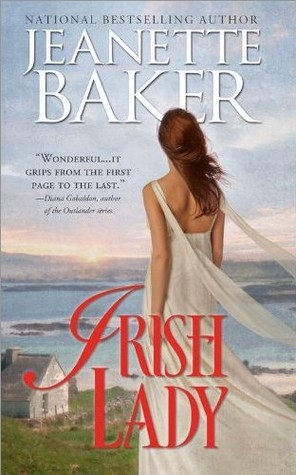
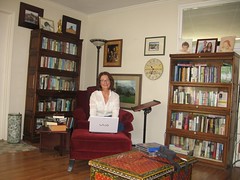 I love color and my space reflects it. My chair and ottoman are a deep garnet-red. A chest hand painted in gold, black and more red serves as a coffee table for my tea habit and the shelves of my bookcases are painted a dark, lacquered green. Even more than writing, reading is my passion. I surround myself with books, hundreds and hundreds of books, written by authors who inspire me, as well as photos of my family to remind me of my focus, and prints of Ireland and Scotland, the settings for many of my novels.
I love color and my space reflects it. My chair and ottoman are a deep garnet-red. A chest hand painted in gold, black and more red serves as a coffee table for my tea habit and the shelves of my bookcases are painted a dark, lacquered green. Even more than writing, reading is my passion. I surround myself with books, hundreds and hundreds of books, written by authors who inspire me, as well as photos of my family to remind me of my focus, and prints of Ireland and Scotland, the settings for many of my novels. I do a lot of my writing in my head before I commit anything to paper. When I’m writing my Jane Austen retellings, I start by rereading the original novel. If it’s a nice day, I do this outside, often going to a nearby stately home or formal garden so that I can soak up the elegant, leisurely atmosphere of days gone by. As I read, I let my mind wander over all the questions that occur to me. What was Henry like as a child and young man? What kind of relationship did he have with his parents and siblings? What was life like for him when his mother died? When did he discover a love for Gothic novels? Where did he read them?
I do a lot of my writing in my head before I commit anything to paper. When I’m writing my Jane Austen retellings, I start by rereading the original novel. If it’s a nice day, I do this outside, often going to a nearby stately home or formal garden so that I can soak up the elegant, leisurely atmosphere of days gone by. As I read, I let my mind wander over all the questions that occur to me. What was Henry like as a child and young man? What kind of relationship did he have with his parents and siblings? What was life like for him when his mother died? When did he discover a love for Gothic novels? Where did he read them? Sometimes I will start writing longhand, on a large notepad, and I often do this out of doors if the weather is good. I’ve written quite a few scenes sitting on the bench in the photo, which is at a nearby stately home. Then, once I’m in full flow I move onto the computer. My study is very plain, because once I get down to the actual business of writing, I don’t like distractions. The walls are a neutral colour without any pictures and there is no furniture apart from essential office furniture. My desk is large because I’m an untidy worker and I need space for all my notes, as well as my research books. I start off in an organised fashion, making neat notes in a word document, but I soon resort to scribbling things down on any piece of paper that comes to hand – an envelope, a copy of the Radio Times, anything. If I’m out, I make notes in a notebook I keep in my handbag, except when I forget it, which is often. Then I will scribble ideas down on an old receipt, train ticket or in fact anything that can be written on. I end up with a jumble of papers on my desk and I daren’t throw anything away in case it turns out to be vital.
Sometimes I will start writing longhand, on a large notepad, and I often do this out of doors if the weather is good. I’ve written quite a few scenes sitting on the bench in the photo, which is at a nearby stately home. Then, once I’m in full flow I move onto the computer. My study is very plain, because once I get down to the actual business of writing, I don’t like distractions. The walls are a neutral colour without any pictures and there is no furniture apart from essential office furniture. My desk is large because I’m an untidy worker and I need space for all my notes, as well as my research books. I start off in an organised fashion, making neat notes in a word document, but I soon resort to scribbling things down on any piece of paper that comes to hand – an envelope, a copy of the Radio Times, anything. If I’m out, I make notes in a notebook I keep in my handbag, except when I forget it, which is often. Then I will scribble ideas down on an old receipt, train ticket or in fact anything that can be written on. I end up with a jumble of papers on my desk and I daren’t throw anything away in case it turns out to be vital.
 Up until six months ago, I wrote in my pantry. That’s right, my pantry. See, we have a small house, barely big enough for the four of us, so my husband created a writing space for me in our combined laundry room/pantry. It was big enough for my desktop and contained all of my writing miscellanea, as you can see. In the summer, it got pretty hot, so I wrote to the constant sound of a fan positioned at the doorway. In the winter, I kept warm from the dryer.
Up until six months ago, I wrote in my pantry. That’s right, my pantry. See, we have a small house, barely big enough for the four of us, so my husband created a writing space for me in our combined laundry room/pantry. It was big enough for my desktop and contained all of my writing miscellanea, as you can see. In the summer, it got pretty hot, so I wrote to the constant sound of a fan positioned at the doorway. In the winter, I kept warm from the dryer. And promptly got a very bad case of writer’s block. Too much light and air, I think. Too many distractions. It took awhile to get over that. I don’t take change well, and it was a shock to my system. Sometimes I find myself going into the pantry to sit down and write, only to be shocked with how my former space is taken up with household stuff.
And promptly got a very bad case of writer’s block. Too much light and air, I think. Too many distractions. It took awhile to get over that. I don’t take change well, and it was a shock to my system. Sometimes I find myself going into the pantry to sit down and write, only to be shocked with how my former space is taken up with household stuff.